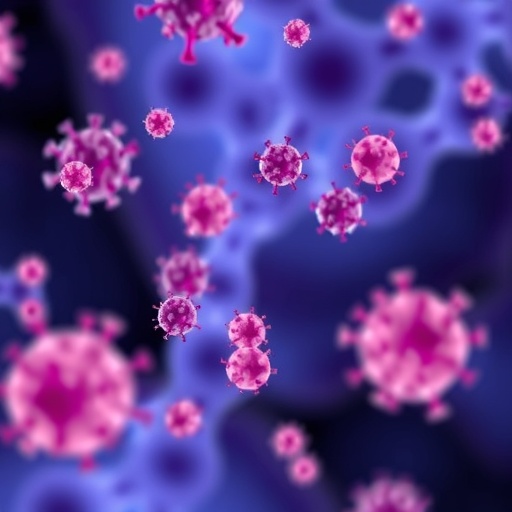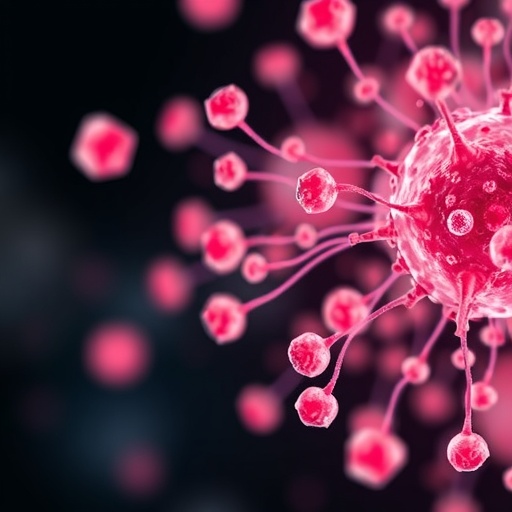In a groundbreaking study published recently in Nature Communications, researchers have unveiled a novel immunomodulatory strategy that promises to revolutionize treatment approaches for triple-negative breast cancer (TNBC). By engineering chimeric exosomes capable of restoring the immunological microenvironment of lymph nodes, this innovative intervention sensitizes TNBC tumors to immunotherapy—a notoriously challenging cancer subtype, often resistant to conventional treatments. This advance marks a significant leap forward in the ongoing battle to unlock the full potential of immune-based therapies against aggressive cancer forms.
TNBC is distinguished by the lack of hormone receptors and HER2 expression, rendering it refractory to many targeted therapies that have benefited other breast cancer patients. Immunotherapy, particularly immune checkpoint blockade, has shown promise but with limited efficacy in TNBC due largely to an immunosuppressive tumor microenvironment and the dysfunctional state of tumor-draining lymph nodes. The lymph nodes act as pivotal hubs for initiating immune responses, but in TNBC, these nodes often exhibit an immune-excluded or suppressed milieu, failing to adequately prime T cells against cancerous cells.
The study introduces a chimeric exosome-based immunomodulator designed to remodel and revitalize the microenvironment of the lymph nodes. Exosomes, nanoscale extracellular vesicles secreted by cells, have garnered attention as potent natural carriers of biological materials capable of influencing recipient cells. By harnessing the intrinsic cell targeting and cargo delivery capacity of exosomes, the researchers engineered them to ferry immune-stimulatory signals directly to lymph nodes, offsetting the immune inertia characteristic of TNBC.
.adsslot_2bLHkTAl0z{width:728px !important;height:90px !important;}
@media(max-width:1199px){ .adsslot_2bLHkTAl0z{width:468px !important;height:60px !important;}
}
@media(max-width:767px){ .adsslot_2bLHkTAl0z{width:320px !important;height:50px !important;}
}
ADVERTISEMENT
Distinctively, these chimeric exosomes derive from a fusion of dendritic cells and tumor cells, thereby blending components that simultaneously present tumor antigens and activate immune pathways. This hybrid nature facilitates the delivery of tumor-specific neoantigens alongside costimulatory signals necessary for effective T cell activation. Upon administration, the exosomes home to draining lymph nodes where they incite antigen-presenting cells and reverse the immunosuppressive microenvironment, eliciting robust cytotoxic T lymphocyte responses.
The authors employed comprehensive in vitro and in vivo models to validate the functionality of these engineered vesicles. Murine models bearing TNBC tumors demonstrated a pronounced reduction in tumor growth rates post-treatment, correlated with enhanced infiltration of activated CD8+ T cells within both the lymph nodes and tumor microenvironment. This reprogramming of the immune landscape effectively lifted the brakes on anti-tumor immunity and synergized with immune checkpoint inhibitors to produce durable therapeutic outcomes.
The translational implications of these findings are vast. By addressing a fundamental obstacle in TNBC immunotherapy—the compromised function of lymph nodes—this approach offers a means to sensitize tumors to existing immune checkpoint inhibitors, broadening the scope of effective treatments. It opens the door for integrating chimeric exosome-based formulations as adjuvants or standalone therapies that reshape tumor-host immune dynamics.
One of the striking aspects of this technology is the modularity and relative biocompatibility of exosome-based delivery systems. Unlike synthetic nanoparticles, exosomes possess inherent membrane proteins and lipids conducive to immune cell interactions, reducing the likelihood of adverse immune reactions. Furthermore, their cell-derived origin facilitates the presentation of native tumor antigens in a physiological context, enhancing specificity and minimizing off-target effects.
The authors also explored the biodistribution and safety profile of these chimeric exosomes in animal models, noting preferential accumulation in lymphoid tissues without noticeable systemic toxicity. This selectivity is crucial in envisioning clinical applications, where minimizing collateral damage and immune-related adverse events remains a priority.
While challenges remain in scaling up exosome production and ensuring batch consistency, advances in bioengineering and cell culture techniques are rapidly addressing these hurdles. The precision with which exosomes can be modified offers a versatile platform not only for cancer therapeutics but also for a range of immune-mediated diseases, placing this research at the frontier of immunoengineering.
Critically, this study contributes to a growing appreciation of the lymph node microenvironment’s central role in orchestrating immune responses against tumors. Therapeutic strategies that restore or enhance lymph node function could become a cornerstone in the design of next-generation immunotherapies, moving beyond targeting tumor cells alone to manipulating the broader immune ecosystem.
In conclusion, the innovative use of chimeric exosomes to rehabilitate impaired lymph node microenvironments represents a novel and promising strategy to overcome TNBC’s immunotherapy resistance. By bridging tumor antigen presentation with immune activation within lymphoid tissues, this approach reinvigorates endogenous anti-cancer immunity and dramatically improves therapeutic outcomes in preclinical models. As the biomedical community continues to unravel the complexities of tumor immunity, such biomimetic interventions could herald a new era of cancer treatment—one where the immune system is fully empowered to eradicate even the most stubborn malignancies.
Subject of Research:
Immunomodulatory strategies for triple-negative breast cancer; restoration of lymph node microenvironment to enhance immunotherapy efficacy.
Article Title:
Chimeric exosomes-derived immunomodulator restoring lymph nodes microenvironment for sensitizing TNBC immunotherapy.
Article References:
Sun, M., Wu, Y., Chen, Z. et al. Chimeric exosomes-derived immunomodulator restoring lymph nodes microenvironment for sensitizing TNBC immunotherapy. Nat Commun 16, 7116 (2025). https://doi.org/10.1038/s41467-025-62543-x
Image Credits:
AI Generated
Tags: cancer immunotherapy advancementschimeric exosomesextracellular vesicles in cancerimmune checkpoint blockade efficacyimmunomodulatory strategiesinnovative cancer treatment approacheslymph node microenvironmentrestoring immune responsesT cell activation in cancerTNBC immunotherapytriple negative breast cancer treatmenttumor-draining lymph nodes





